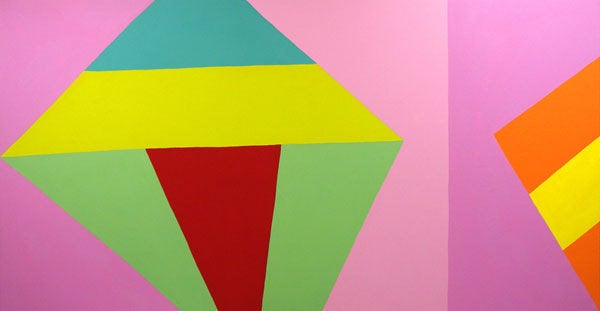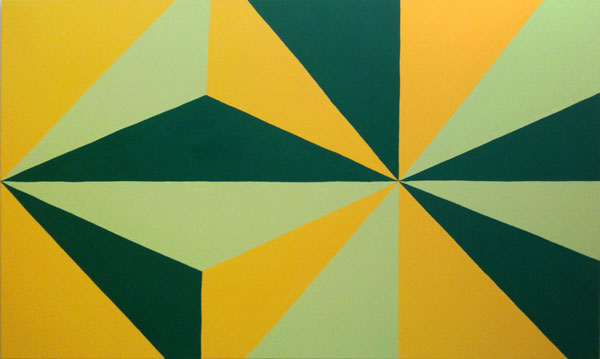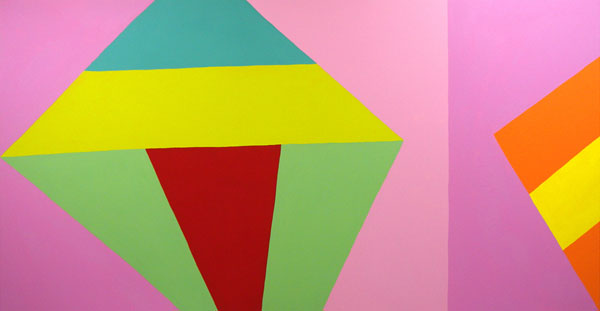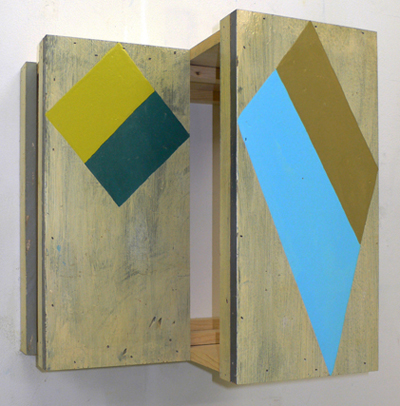
Don Christensen has a gorgeous show of large, hard edge abstract paintings up in Williamsburg in Brooklyn at Sideshow gallery. From Kenneth Noland to the Contortions and back again, here's a sample of the wide-ranging talk we had.
Liz: I love the paintings in the show. It's a lot of hard edge abstraction. You assisted Kenneth Noland, one of my favorite artists. Do you feel like you were influenced by him or were you drawn to him in the first place?
Don: I think definitely influenced by him, and not just him. I went to art school in 1969, 1970 and I remember seeing Artforum. And the first things that really struck me were Frank Stella paintings. And then shortly after that, the big Noland horizontal striped paintings, I discovered those. I dropped out of school. I came to New York. I got to meet Ken Noland. I actually went to work in his studio for a while, so of course, he had an influence. But after a few years of working with Noland and then Jules Olitski, like in the early 70's, I dropped out of the whole scene and started playing music, which I did until 1985.

Siena Closing, 2010, 60x100 inches, acrylic on canvas
L: And you're a drummer. So whom were you playing with?
D: I was playing with a band called the Contortions, then the Raybeats and another band, the Bush Tetras. And at a certain point I just sort of burned out on all that physically, mentally, emotionally.
L: How did you transition to painting?
D: I'd always been picking stuff up off the street because I came to New York in the 70's and lived in a loft. I'd been collecting these pieces of wood out of dumpsters from renovations. In 1990 I decided I was going to spend the summer and take it easy at the beach, actually out in Long Island. My brother lived out there and he had a studio, and I had these pieces of wood and it just seemed natural. He let me use some of his paints and I started painting on them. And I went like "God this is great! This is really fun!"
L: And what were you painting on them?
D: I was really interested in color and I discovered that the way to get the color on the little pieces of wood was just to make brush strokes and so they ended up being crosses.
Later I started drawing this "thingy", which I call these things you see on the wall. It's one continuous line, almost like an infinity thing, and usually there'd be eight loops that would return on itself. I started doing them on canvas, bigger. The canvases were difficult and weren't satisfying and I finally got up to oh five by seven, maybe eight foot high was the biggest one.
The "thingys" that I'm looking at on the wall now, especially the middle one or the pink one on the right there... that to me is really successful because it sort of feels like it just appeared there. There was a sort of a natural "here's this image" and when it got bigger, when it got onto canvas, I couldn't get that. It had more of that I'M A PAINTING feeling.
So I went back to wood. But I wanted to make larger pieces with the wood. A lot of it was found wood. Some of it was wood I bought. I would paint the lumber and then cut it up and then stick it together.
L: I love the colors in the show, very sixties. I almost felt the one on the left, when you walk into the second room, was like a set for Laugh In.

South of the Park, 2009, oil on canvas, 59 x 116 inches
D: Oh. That's good. The pictures that people have taken, of people standing in front of the paintings... the paintings are great backdrops for photographs.
L: I bet. I love that about big paintings.
L: There is something great, which I really love and I think is the mark of a great painting...there's something very obvious, like "oh yeah, of course!"
D: Yeah. I know totally what you mean. When you see a piece that you like there's that big "ah ha" moment.
L: You also had the wooden pieces and some of them, they're tables but they're hanging on the wall sideways.
D: They are. There are tables and stools and stuff. And that came about because I had bought some stools in yard sales thinking that I would make some of my wooden paintings out of them. And I started painting on them before I took them apart, hung one on the wall and was "hmmm that's kind of cool," you know?

2 Steps, 2008, oil on wood construction, 20" hi x 30" wide x 18" depth
L: Well I think we've kind of... is there anything else?
D: Here's what I was saying earlier... sometimes it's easier for me to make an analogy to music.
L: Oh good, give me an ending for this.
D: Ok. Representational or narrative or painting has a lot of references to it. I kind of think of that as like they're like songs with lyrics and the lyric is poetic or maybe has some kind of meaning or it's using language to evoke another response along with the musical backdrop.
And abstract painting is like music that doesn't have words, instrumental music. It could be classical music or jazz because music in itself is abstract. The emotionality that may come out of a piece of music may strike a lot of people the same way or similar ways but nobody could say exactly what it is. There's no referential thing informing you about what you're looking at. And that's my analogy to abstract art.
L: Thank you very much.
D: You're welcome. Thank you.
Don Christensen, Digitalized is up through October 10th at Sideshow Gallery in Brooklyn.
A complete transcript of the interview can be found here.
Liz Markus' third solo exhibition in New York opens November 18th at ZieherSmith Gallery.

Liz Markus, Improved, 2010, acrylic and spray paint on canvas